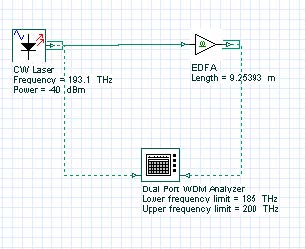In this example we show optimization of a single parameter by using SPO. It shows how to optimize the fiber length to maximize the amplifier gain. The project is given in EDFA fiber length optimizationFig.osd. In order to run the optimizations with the components shown in Figure 1, the Laser power is -40 dBm. Default EDFA parameters are used.
Figure 1: Project layout
The optimization will optimize the Length parameter of the EDFA to get maximum gain as measured by Dual Port WDM Analyzer.
To set up the optimization, go to Tools > Optimizations and insert a SPO Optimization. Then, select Maximize type of optimization in the Main tab and set Result tolerance to 0.1. In the Parameter tab, add a Length parameter of the EDFA component into the Selected list. In the Result tab, add Gain 1 (dB) result of the Dual Port WDM Analyzer into the Selected list.
In order to run the optimizations, go to File > Calculate from the Main menu, and enable Run optimizations in the Calculation dialog box, which runs the simulation.
After 11 passes, fiber length for maximum gain is found to be 9.86. In this case, EDFA gain is about 38.1 dB.


